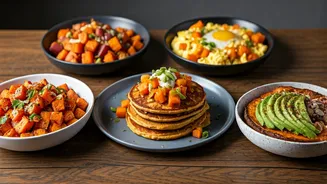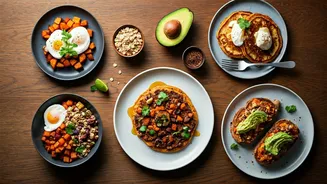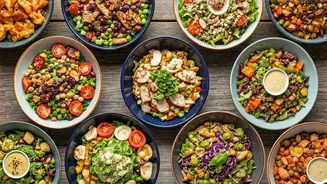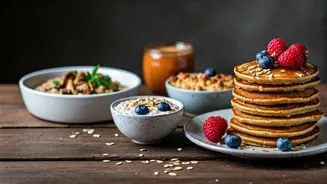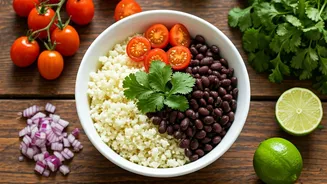Planning for Speed
The cornerstone of preparing swift and wholesome dinners lies in effective planning. Before diving into any cooking, it's essential to survey your pantry
and fridge, noting the ingredients available. This preliminary step prevents unnecessary trips to the grocery store during the week. Consider crafting a weekly meal plan, outlining the dinners you intend to prepare. Include all the components of the meal to reduce decision fatigue. Once the meals are planned, pre-chop vegetables, portion out proteins, and pre-measure spices whenever feasible. This preparation significantly trims down cooking time. Furthermore, keep essential ingredients like quick-cooking grains (quinoa, couscous), frozen vegetables, and lean proteins readily available. This strategic pantry setup guarantees that even with a short window, you're equipped to create a satisfying and healthy meal quickly. Planning isn't just about speed; it's about minimizing the stress associated with meal preparation.
Time-Saving Strategies
Mastering the art of speedy cooking involves embracing several time-saving tactics. A valuable approach involves utilizing pre-cut vegetables and pre-cooked grains to bypass initial chopping and cooking durations. Frozen vegetables offer a convenient alternative; they retain nutrients and cook fast. Embrace the power of one-pot or sheet-pan meals, which minimize both cooking time and cleanup efforts. These methods allow all ingredients to cook simultaneously, simplifying the process. Another strategy involves leveraging the microwave for tasks like steaming vegetables or partially cooking proteins. When possible, prepare sauces or marinades in advance, keeping them ready in the refrigerator for immediate use. Prioritize recipes with short cooking times, such as stir-fries, omelets, and quick pasta dishes. These strategies combined transform the challenge of making a quick dinner into a streamlined and enjoyable activity.
Quick Recipe Ideas
Several recipes perfectly fit the 20-minute dinner criteria. A vibrant stir-fry with your favorite vegetables and a protein source such as chicken or tofu provides a complete meal. Use pre-cut veggies and quick-cooking sauces to speed up the process. Omelets, which are versatile and adaptable, offer another fast option. You can customize them with different fillings like cheese, spinach, or mushrooms, and they cook in just minutes. Pasta dishes are always dependable; choose whole-wheat pasta for added fiber and pair it with a light sauce, canned tuna or quickly sautéed vegetables. Soups made from a pre-made broth or stock that includes canned beans or leftover cooked chicken work nicely. For an even quicker option, assemble a simple salad with grilled chicken or chickpeas, dressed with a tasty vinaigrette, for a refreshing and healthy meal.
Smart Ingredient Choices
Selecting the right ingredients is crucial to ensure both speed and nutritional value in your meals. Focus on ingredients that cook rapidly and retain nutritional benefits. Opt for lean proteins such as chicken breast, fish fillets, and tofu, as they cook faster compared to larger cuts of meat. Utilize fresh or frozen vegetables, as they are essential for adding vitamins and fiber without long cooking times. Choose whole grains like quinoa, couscous, or pre-cooked brown rice over refined alternatives. Stock up on canned beans, lentils, and chickpeas for easy protein and fiber additions. Incorporate healthy fats like avocado, olive oil, and nuts in moderation to boost the overall nutritional profile. Reading labels carefully can help you choose products with lower sodium and added sugar, contributing to a healthier outcome.
Healthy Meal Prep
Meal prepping is a game-changer when it comes to healthy eating during busy times. Consider dedicating a few hours each week to prepare ingredients or partially cook meals. This could involve washing and chopping vegetables, portioning out proteins, or preparing a large batch of grains. Storing ingredients in separate containers allows for quick assembly of meals during the week. Make extra portions of dinner and use them for lunch the following day. When prepping, think about meals that reheat well, such as stews, soups, and casseroles. Keep a supply of pre-portioned snacks like nuts, fruits, and yogurt in place for easy snacking. This strategy greatly diminishes the time and effort needed to prepare a quick and healthy meal. Planning and doing some preparation makes consistent healthy eating achievable, even when time is limited.
Balancing Nutrition
Striving for a balanced diet within the constraints of limited time is both achievable and essential. Ensure each meal incorporates a combination of protein, complex carbohydrates, and healthy fats. Proteins, such as lean meats or beans, aid in satiety and muscle maintenance. Complex carbohydrates, like whole grains or vegetables, supply sustained energy. Healthy fats, found in avocados, nuts, and olive oil, are vital for nutrient absorption and overall health. Aim for a generous portion of vegetables in each meal; they are packed with vitamins and contribute to a feeling of fullness. Control portion sizes to manage calorie intake. Make smart choices about snacks, opting for nutrient-dense options such as fruits, vegetables, or a handful of nuts to avoid unhealthy cravings. Prioritizing a balanced approach guarantees that your quick meals are not just fast, but also beneficial for your overall health.



